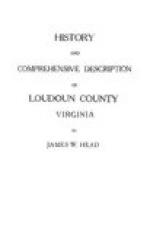And thus were gradually introduced the methods and appliances of a more advanced civilization. The pioneer and his wife, hearing of these things, would occasionally “go to town” to “see the sights,” and would there discover that there were many useful and convenient articles for the farm and kitchen which might be procured in exchange for their corn, bacon, eggs, honey, and hides; and although the shrewd merchant was careful to exact his cent per cent, the prices asked were little heeded by the purchaser who was as ignorant of the value of the commodities offered as he was delighted with their novelty and apparent usefulness.
DRESS.
The subject of dress is approached with reluctance and its description diffidently essayed. But the task has seemed mandatory as the manners of a people can not otherwise be fully understood. The stately, ceremonious intercourse of the sexes, the stiff and elaborate walk of Loudoun men and women of Colonial and post-Revolutionary times is traceable almost solely to the costuming of that period. How could ladies dance anything but the stately minuet, when their heads were veritable pyramids of pasted hair surmounted by turbans, when their jeweled stomachers and tight-laced stays held their bodies as tightly as would a vise, when their high-heeled shoes were as unyielding as if made of wood, and their trails of taffeta, often as much as fifteen yards long, and great feathered head-dresses compelled them to turn round as slowly as strutting peacocks? How could the men, with their buckram-stiffened coat-shirts, execute any other dance, when their elaborate powdered wigs compelled them to carry their hats under their arms, and their swords concurrently required dexterous management for the avoidance of tripping and mortifying falls?
Children were laced in stays and made to wear chin supports, gaps, and pads so as to give them the graceful carriage necessary to the wearing of all this weight of stiff and elaborate costume, which was all of a piece with the character of the assemblies and other evening entertainments, the games of cards—basset, loo, piquet, and whist—with the dancing, the ceremonious public life of nearly every class of society, with even the elaborate funeral ceremonies, and the sedulousness with which “persons of quality” thought it incumbent upon themselves to maintain the distinctions of rank as symbolized in costume.
The tie-wig, bob-wig, bag-wig, night-cap-wig, and riding-wig were worn by the gentleman of quality as occasion required. At times he wore, also, a small three-cornered cocked hat, felt or beaver, elaborately laced with gold or silver galloon. If he walked, as to church or court, he carried, in addition to his sword, a gold or ivory-headed cane, at least five feet long, and wore square-toed, “low-quartered” shoes with paste or silver buckles. His stockings, no matter what the material, were tightly stretched




